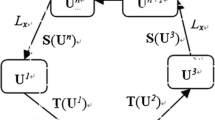Abstract
Marine landslide due to gas hydrate dissociation is a kind of potential heavy hazards. Numerical simulation was processed to investigate the deformation, landslide and effects of main factors on the critical scale of dissociation zone to induce marine landslides during/after dissociation of gas hydrate. A simple method for analyzing the critical scale was presented based on the limit equilibrium method. It is shown that the maximum settlement is located near the upper side of the dissociation zone. The soil near the lower side of the dissociation zone uplifts. There is a critical scale of dissociation zone over which landslide will occur under given conditions. Expansion modes of the dissociation zone have obvious effects on the critical scale.








Similar content being viewed by others
References
Briaud JL, Chaouch A (1997) Hydrate melting in hydrate soil around hot conductor. J Geotech Geoenviron Eng 123(7):645–653
Brooks JM, Cox BH, Bryant WR, Kennicutt MC II, Mann RG, McDonald TJ (1986) Association of gas hydrates and oil seepage in the Gulf of Mexico. Org Geochem 10(1–3):221–234
Bugge T, Befring S, Belderson RH, Eidvin T, Jansen E, Kenyon NH, Holtedahl H, Sejrup HP (1987) A giant three-stage submarine slide off Norway. Geo-Mar Lett 7(4):191–198
Chaouch A, Briaud JL (1997) Post melting behavior of gas hydrates in soft ocean Sediments. In: offshore technology conference (OTC8298), pp 1–11
Jung WY, Peter RV (2004) Effects of bottom water warming and sea level rise on Holocene hydrate dissociation and mass wasting along the Norwegian-Barents continental Margin. J Geophys Res 109(B6):B06104
Kwon TH, Cho GC, Santamarina JC (2008) Gas hydrate dissociation in sediments: pressure–temperature evolution. Geochem Geophys Geosystem 9(2):Q03019
Li XP, He SM (2012) Progress in stability analysis of submarine slopes considering dissociation of gas hydrate. Environ Earth Sci 66(3):741–747
Liu LL, Lu XB, Zhang XH (2015) A theoretical model for predicting the spatial distribution of gas hydrate dissociation under the combination of depressurization and heating without the discontinuous interface assumption. J Petrol Sci Eng 133:589–601
Lu XB, Wang L, Wang SY, Li QP (2008) Study on the mechanical properties of THF hydrate Deposit. In: Proceedings of 18th international offshore and polar engineering conference, vancouver, canada, ISOPE1, pp 57–60
Lu XB, Li QP, Wang L (2010) Instability of seabed and pipes induced by NGH dissociation, In: Proceedings of 20th International Offshore and Polar Engineering Conference, Beijing, China, ISOPE, vol, 1pp 110–114
Marcia KM, Rich C, Timothy JC, George DG, Paul AH, Thomas BR, Omer S, Frank S (2012) Review of flow rate estimates of the deepwater horizon oil spill. Proc Natl Acad Sci 109(50):20260–20267
Milkov AV (2000) Worldwide distribution of submarine mud volcanoes and associated gas hydrates. Mar Geol 167:29–42
Sloan ED (1998) Clathrates of natural gases. Dekker, New York, p 705
Wang SY, Zheng W, Lu XB (2009) The effects of gas hydrate dissociation on the stability of pipeline in seabed. In: Proceedings of 19th international offshore and polar engineering conference, Osaka, Japan, 1: 49–53
Xu W, Germanovich LN (2006) Excess pore pressure resulting from methane hydrate dissociation in marine sediments: a theoretical approach. J Geophys Res 111:B011104
Zhang XH, Lu XB, Li QP (2010) Thermally induced evolution of phase transformations in gas hydrate sediment. Sci China Phys Mech Astron 53(8):1530–1535
Zhang XH, Lu XB, Zheng ZM (2011) Layered fracture and outburst due to dissociation of hydrate. J Petrol Sci Eng 76:212–216
Zhang XH, Lu XB, Zhang LM, Wang SY, Li QP (2012) Experimental study on mechanical properties of methane-hydrate-bearing sediments. Acta Mech Sin 28(5):1–11
Zhang XH, Lu XB, Shi YH, Xia Z, Liu WT (2015) Centrifuge experimental study on instability of seabed stratum caused by gas hydrate dissociation. Ocean Eng 105:1–9
Zheng ZC, Chen JR, Zhu ZY (2004) Physical and mechanical characteristics of seabed soils and its geological environment in South China Sea. Hydrogeol Eng Geol 31(4):50–53 (in Chinese)
Acknowledgements
This paper is supported by The National Natural Science Foundation of China (Nos. 51239010, 11272314) and Project of CAS-CNPC Strategic Alliance.
Author information
Authors and Affiliations
Corresponding author
Rights and permissions
About this article
Cite this article
Lu, X.B., Chen, X.D., Lu, L. et al. Numerical simulation on the marine landslide due to gas hydrate dissociation. Environ Earth Sci 76, 172 (2017). https://doi.org/10.1007/s12665-017-6477-0
Received:
Accepted:
Published:
DOI: https://doi.org/10.1007/s12665-017-6477-0



